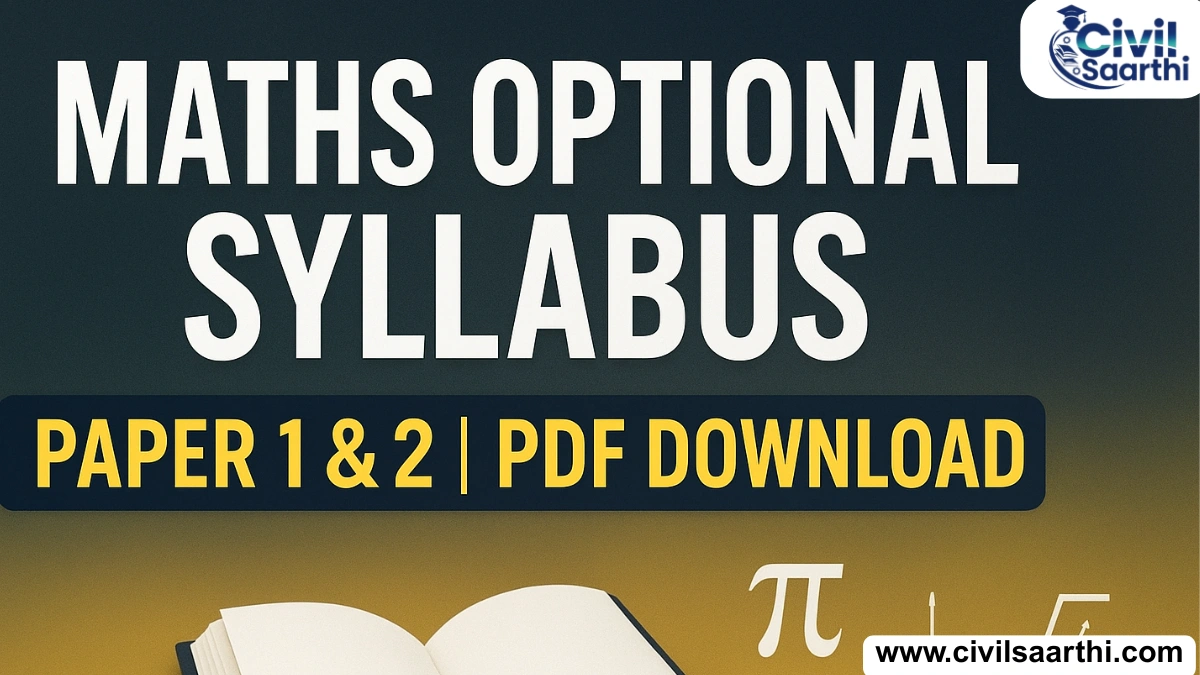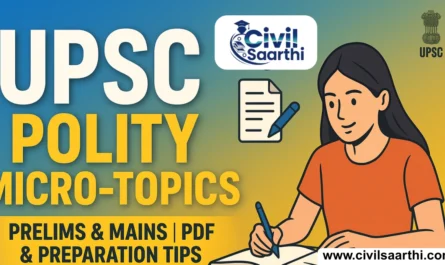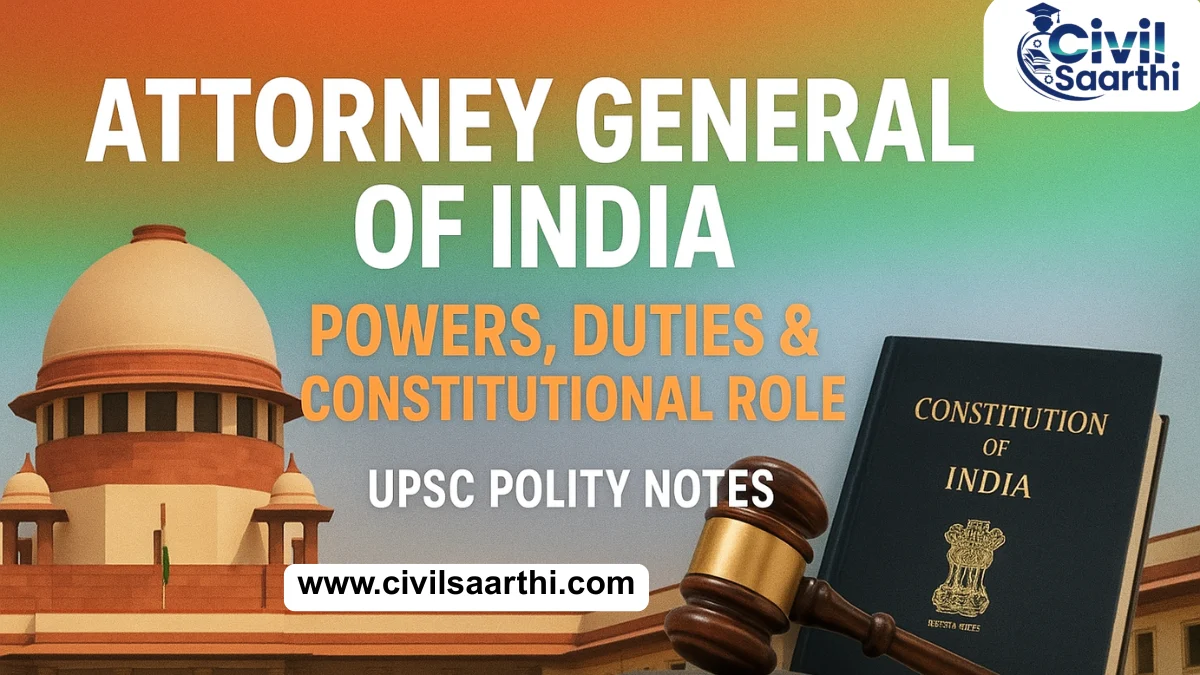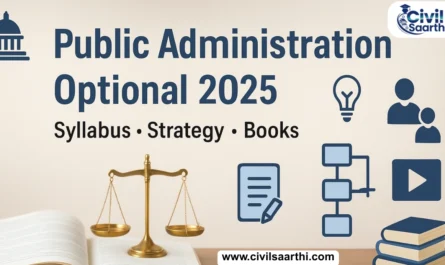The UPSC Maths Optional Syllabus 2025 is ideal for aspirants with a strong mathematics background or engineering students. It is known for its objectivity, high-scoring potential, and well-defined topics. This article provides a complete overview of the UPSC Maths Optional Syllabus 2025, including topic-wise breakdowns of Paper 1 and Paper 2, preparation strategy, recommended books, and frequently asked questions.
UPSC Maths Optional Syllabus 2025
The UPSC Maths Optional Syllabus 2025 is divided into two papers: Paper 1 focuses on foundational topics like Algebra, Calculus, and Geometry, while Paper 2 covers advanced subjects such as Complex Analysis, PDEs, and Fluid Dynamics. This syllabus is precise, scoring, and ideal for candidates with a strong background in mathematics or engineering.
UPSC Maths Optional Syllabus 2025 PDF Download
The UPSC Maths Optional Syllabus 2025 is divided into two papers, each of 250 marks. Paper 1 covers foundational areas such as Algebra, Calculus, and Geometry, while Paper 2 focuses on advanced areas like Mechanics, Fluid Dynamics, and Numerical Analysis. Below is a quick summary table. The links to download the UPSC Maths Optional Syllabus 2025 PDF has been shared below.
Download UPSC Maths Optional Syllabus 2025 PDF
UPSC Maths Optional Syllabus 2025 Official
The UPSC Maths Optional Syllabus 2025 follows a fixed and structured approach. With no subjective interpretation required, performance purely depends on accuracy and practice. Candidates who are comfortable with mathematical concepts can score very high in this optional. The UPSC Maths Optional Syllabus 2025 is especially popular among engineering and science graduates due to its technical nature.
UPSC Mathematics Optional Syllabus for Paper 1
(1) Linear Algebra :
Vector spaces over R and C, linear dependence and independence, subspaces, bases, dimensions, Linear transformations, rank and nullity, matrix of a linear transformation. Algebra of Matrices; Row and column reduction, Echelon form, congruence’s and similarity; Rankof a matrix; Inverse of a matrix; Solution of system of linear equations; Eigenvalues and eigenvectors,
characteristic polynomial, Cayley-Hamilton theorem, Symmetric, skew-symmetric, Hermitian, skewHermitian, orthogonal and unitary matrices and their eigenvalues.
(2) Calculus :
Real numbers, functions of a real variable, limits, continuity, differentiability, mean-value theorem, Taylor’s theorem with remainders, indeterminate forms, maxima and minima, asymptotes; Curve tracing; Functions of two or three variables; Limits, continuity, partial derivatives, maxima and minima, Lagrange’s method of multipliers, Jacobian. Riemann’s definition of definite integrals; Indefinite integrals; Infinite and improper integral; Double and triple integrals (evaluation techniques only); Areas, surface and volumes.
(3) Analytic Geometry :
Cartesian and polar coordinates in three dimensions, second degree equations in three variables, reduction to Canonical forms; straight lines, shortest distance between two skew lines, Plane, sphere, cone, cylinder, paraboloid, ellipsoid, hyperboloid of one and two sheets and their properties.
(4) Ordinary Differential Equations :
Formulation of differential equations; Equations of first order and first degree, integrating factor; Orthogonal trajectory; Equations of first order but not of first degree, Clairaut’s equation, singular solution. Second and higher order liner equations with constant coefficients, complementary function, particular integral and general solution. Section order linear equations with variable coefficients, Euler-Cauchy equation; Determination of complete solution when one solution is known using method of variation of parameters. Laplace and Inverse Laplace transforms and their properties, Laplace transforms of elementary functions.
Application to initial value problems for 2nd order linear equations with constant coefficients.
(5) Dynamics and Statics :
Rectilinear motion, simple harmonic motion, motion in a plane, projectiles; Constrained motion; Work and energy, conservation of energy; Kepler’s laws, orbits under central forces. Equilibrium of a system of particles; Work and potential energy, friction, Common catenary; Principle of virtual work; Stability of equilibrium, equilibrium of forces in three dimensions.
(6) Vector Analysis :
Scalar and vector fields, differentiation of vector field of a scalar variable; Gradient, divergence and curl in cartesian and cylindrical coordinates; Higher order derivatives; Vector identities and vector equation. Application to geometry : Curves in space, curvature and torsion; Serret-Furenet’s formulae. Gauss and Stokes’ theorems, Green’s indentities.
UPSC Mathematics Optional Syllabus for Paper 2
(1) Algebra :
Groups, subgroups, cyclic groups, cosets, Lagrange’s Theorem, normal subgroups, quotient groups, homomorphism of groups, basic isomorphism theorems, permutation groups, Cayley’s theorem. Rings, subrings and ideals, homomorphisms of rings; Integral domains, principal ideal domains, Euclidean domains and unique factorization domains; Fields, quotient fields.
(2) Real Analysis :
Real number system as an ordered field with least upper bound property; Sequences, limit of a sequence, Cauchy sequence, completeness of real line; Series and its convergence, absolute and conditional convergence of series of real and complex terms, rearrangement of series. Continuity and uniform continuity of functions, properties of continuous functions on compact sets. Riemann integral, improper integrals; Fundamental theorems of integral calculus. Uniform convergence, continuity, differentiability and integrability for sequences and series of functions; Partial derivatives of functions of several (two or three) variables, maxima and minima.
(3) Complex Analysis :
Analytic function, Cauchy-Riemann equations, Cauchy’s theorem, Cauchy’s integral formula, power series, representation of an analytic function, Taylor’s series; Singularities; Laurent’s series; Cauchy’s residue theorem; Contour integration.
(4) Linear Programming :
Linear programming problems, basic solution, basic feasible solution and optimal solution; Graphical method and simplex method of solutions; Duality. Transportation and assignment problems.
(5) Partial Differential Equations :
Family of surfaces in three dimensions and formulation of partial differential equations; Solution of quasilinear partial differential equations of the first order, Cauchy’s method of characteristics; Linear partial differential equations of the second order with constant coefficients, canonical form; Equation of a vibrating string, heatequation, Laplace equation and their solutions.
(6) Numerical Analysis and Computer Programming :
Numerical methods: Solution of algebraic and transcendental equations of one variable by bisection, Regula-Falsi and Newton-Raphson methods, solution of system of linear equations by Gaussian Elimination and Gauss-Jorden (direct), Gauss-Seidel (iterative) methods. Newton’s (forward and backward) and interpolation, Lagrange’s interpolation. Numerical integration: Trapezoidal rule, Simpson’s rule, Gaussian quadrature formula. Numerical solution of ordinary differential equations : Eular and Runga Kutta methods.
Computer Programming : Binary system; Arithmetic and logical operations on numbers; Octal and
Hexadecimal Systems; Conversion to and from decimal Systems; Algebra of binary numbers.
Elements of computer systems and concept of memory; Basic logic gates and truth tables, Boolean algebra, normal forms.
Representation of unsigned integers, signed integers and reals, double precision reals and long integers.
Algorithms and flow charts for solving numerical analysis problems.
(7) Mechanics and Fluid Dynamics :
Generalised coordinates; D’Alembert’s principle and Lagrange’s equations; Hamilton equations; Moment of
inertia; Motion of rigid bodies in two dimensions.
Equation of continuity; Euler’s equation of motion for inviscid flow; Stream-lines, path of a particle; Potential flow; Two-dimensional and axisymmetric motion; Sources and sinks, vortex motion; Navier-Stokes equation for a viscous fluid.
Benefits of Choosing Mathematics as an Optional Subject
Choosing mathematics for the UPSC Maths Optional Syllabus 2025 offers several advantages. It is one of the most scoring optionals and has a clearly defined syllabus with minimal overlap with GS papers.
- Objective questions with definite answers
- No influence of examiner’s bias
- High scoring potential with good preparation
- Ideal for candidates with engineering or math backgrounds
- Helps build analytical and logical thinking
UPSC Maths Optional Syllabus Preparation Strategy
A focused and consistent approach is essential to crack the UPSC Maths Optional Syllabus 2025. Candidates must emphasize understanding over rote memorization and practice extensively.
- Finish the syllabus topic-wise with standard books
- Solve previous 10-year UPSC question papers
- Maintain formula sheets and quick revision notes
- Attempt mock tests regularly under timed conditions
- Analyze mistakes and improve accuracy
Books to Study for UPSC Mathematics Optional Syllabus 2025
Choosing the right books is crucial for mastering the UPSC Maths Optional Syllabus 2025. Standard textbooks along with practice books help develop accuracy and confidence.
UPSC Maths Optional Paper 1 – Recommended Books
| UPSC Maths Optional Paper 1 – Recommended Books | |
| Topic | Books |
| Linear Algebra | K.C. Prasad and K.B. Datta / Hoffman and Kunze |
| Calculus & Real Analysis | R.G. Bartle / Tom Apostol |
| ODEs & Vector Analysis | MD Raisinghania / Murray Spiegel |
| Analytical Geometry | P.K. Jain and Khalil Ahmad |
UPSC Maths Optional Paper 2 – Recommended Books
| UPSC Maths Optional Paper 2 – Recommended Books | |
| Topic | Books |
| Complex Analysis | Schaum’s Outline / Churchill and Brown |
| Linear Programming | Kanti Swarup / S.D. Sharma |
| PDE & Numerical Analysis | S.S. Sastry / Grewal |
| Mechanics & Fluid Dynamics | F. Chorlton / M.D. Raisinghania |
How to Approach UPSC Maths Optional Syllabus?
To crack the UPSC Maths Optional Syllabus 2025, focus on building strong theoretical understanding and solving diverse problems. Regular revision and timed practice are essential.
Approach for UPSC Maths Optional Syllabus 2025:
- Complete the theory first before starting problem sets
- Stick to the UPSC syllabus; avoid research-level content
- Focus on diagrammatic representation and stepwise solving
- Avoid skipping difficult topics like PDE or Fluid Mechanics
- Prioritize accuracy over speed during practice
UPSC Maths Optional Syllabus 2025 FAQs
Is the UPSC Maths Optional Syllabus 2025 suitable for engineers?
Yes, the UPSC Maths Optional Syllabus 2025 is ideal for engineering graduates due to its logical and technical nature.
Can a non-math graduate choose the UPSC Maths Optional Syllabus 2025?
Yes, with strong interest and prior exposure, even non-math graduates can handle the UPSC Maths Optional Syllabus 2025 effectively.
What is the scoring potential of the UPSC Maths Optional Syllabus 2025?
Aspirants can score 280+ with good preparation in the UPSC Maths Optional Syllabus 2025 due to its objective nature.
How long does it take to complete the UPSC Maths Optional Syllabus 2025?
On average, it takes 5–6 months of consistent study to complete the UPSC Maths Optional Syllabus 2025.
Is coaching necessary for the UPSC Maths Optional Syllabus 2025?
Coaching can help, but self-study with the right resources is enough for the UPSC Maths Optional Syllabus 2025.
Does UPSC repeat questions in Maths optional?
Yes, the UPSC Maths Optional Syllabus 2025 often sees pattern-based repetition, making previous papers very important.
Where can I get the UPSC Maths Optional Syllabus 2025 PDF?
You can download the UPSC Maths Optional Syllabus 2025 PDF from UPSC’s official website or request a formatted version from here.







